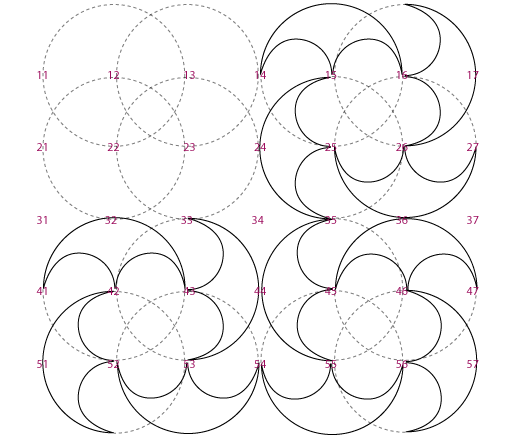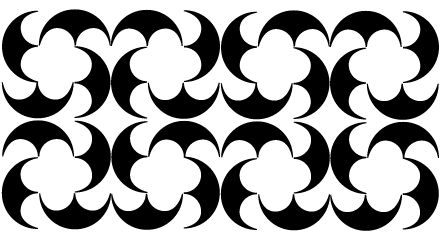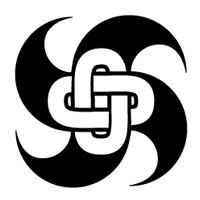In Greece it’s not uncommon to find so-called pelta vortices which consist of four peltae with touching tips. The basis of the motif is a pattern featuring four overlapping circles. The peltae are arranged in a cross, while their curves hint at rotation (Fig. 42). As a result the pattern appears more dynamic and less rigid than, for example, the groups of four peltae und rosettes.
 |
Although the motif known as a pelta vortex is a self-contained entity, it appears only rarely as an isolated motif. As a rule, parallel rows of pelta vortices cover a larger area.
In the examples that have so far been discovered in Greece the design is arranged so that the direction of the pelta vortices changes. To a certain degree this symmetrical arrangement cancels out the motif’s inner dynamism (Fig. 43).
 |
Heart-shaped and four-sided figures (or triangular around the edges) with concave sides arise between the decorative figures. In the concave rectangles small motifs can often be found: squares with staircase borders, rosettes or crosses.
An important component of the pelta vortex is the so-called Solomon’s knot, which occupies the cross-shaped field between the peltae (Fig. 44).
 |
The pelta vortices aren’t usually connected to one another. Only on the mosaic from Nikopolis are they chained together by means of black tessellae between the pelta backs and inward-rolling sides. The outer sides of some pelta curves touch each other on a mosaic in Melos, but this could be a mistake by the artist.
The decoration frequently appears around the edges. In two outer corners on a mosaic in Sparta four pelta vortices can be found. The external friezes of two mosaics from Melos and Nikopolis and the longer sides of a floor from Kastelli Kisamou are also decorated with pelta vortices. On the mosaics from Melos und Kastelli Kisamou only a single row of pelta vortices appears. In accordance with the baroque character of the mosaic in Nikopolis they are doubled.
On an oblong area of an Athenian mosaic four rows of pelta vortices appear eight times. Another mosaic in Athens couldn’t be fully excavated, but it appears to have been filled with five times three rows of pelta vortices.
Generally the peltae are black, while the Solomon’s knot is emphasised by rows of small red and yellow stones. Deviations from the classical pelta form are rare. On an example from Sparta a small, bright point appears on the black peltae. On three elegant pavements dating from Late Antiquity the peltae possess spiral-shaped, inward-turning endings.